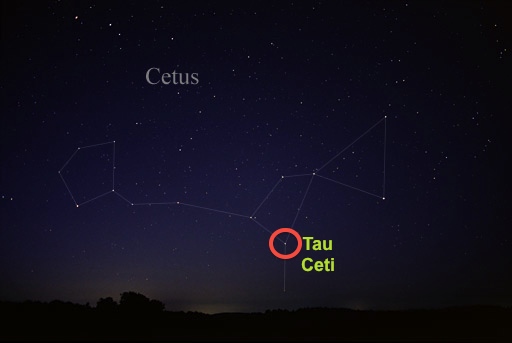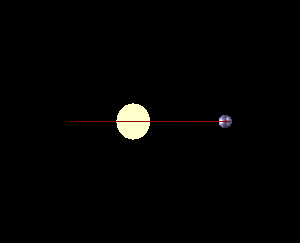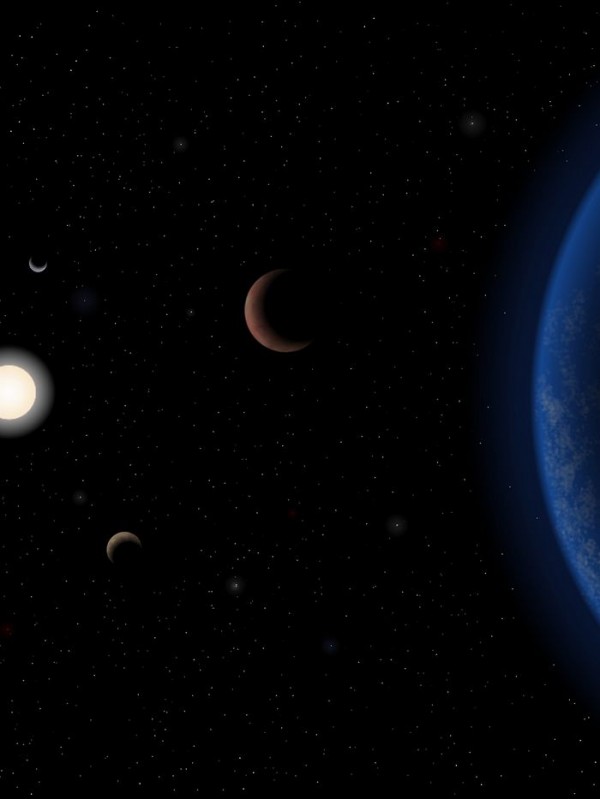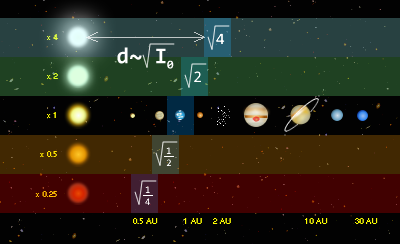"Death comes to all, but great achievements build a monument which shall endure until the sun grows cold." -Ralph Waldo Emerson
In the great cosmic ocean, there's only one planet that we know -- for certain -- has the right conditions and history to result in intelligent life: our own.
Life -- or even intelligent life -- may be possible in environments vastly different than our own: around different classes of stars, at different temperatures, and even with different molecules and/or chemical elements.
But we know for certain that it's definitely possible with the conditions we have here on Earth, given our Sun with its properties and its distance from us.

Image credit: F. Espenak of http://astropixels.com/, from this past August, 2012.
Our Sun is the only star in its system, has the temperature and luminosity properties of a G-type star, and the Earth is located at just the right distance that liquid water -- existing for long periods of time -- is prevalent on our world's surface.
You might be curious, looking up at the night sky, what the nearest star to us is that is also a G-type star, and the only star in its Solar System. To find it, just look in the constellation of Cetus, and find this clearly visible naked-eye star.
Tau Ceti is the 20th closest star system to us, only 12 light years distant. (That's less than a third the length of Han Solo's famous Kessel Run!) It's the same class as our Sun -- nearly the same temperature -- with 78% of our Sun's mass, and a corresponding smaller radius. It's also less active and less variable than our own Sun, and slightly "yellower" due to the slightly lower temperature.
Viewed from the same distance, the Sun and Tau Ceti would appear slightly different from one another, with the Sun on the left and Tau Ceti on the right.
For a long time, we didn't know whether Tau Ceti had any possibly habitable planets around it, or -- for that matter -- any planets at all! It's true, of course, that we've found thousands of planets around thousands of stars, and we now believe that the vast majority of stars do have planets around them.
But that doesn't mean that we can look at any star we choose and know whether there are planets around it or not. The way we've found most of these planets is by the transit method, where we look at the variability in the amount of light coming from a distant star. If there's a planet (or multiple planets) that pass in between that star and our line-of-sight, it will block a small amount of that light during that planetary transit.
And over time (or, I should say, over many orbits), we can observe multiple transits by the same extra-solar planet, allowing us to determine how many planets there are in that star system that transit their parent star, as well as to measure the radius and semimajor axes of those worlds.
Even though this is likely to soon become the most prolific method of detecting extra-solar planets, it also has a fatal flaw which makes it unsuitable for detecting most of the planets around most of the stars out there.
Think about it for a second. The Sun is a pretty big object: it's slightly over one million kilometers (1.38 million, to be precise) in diameter, or about 109 times the diameter of the Earth. But it's really, really far away from the Earth, at an average distance of 150 million kilometers. We don't usually draw the Earth, Sun and Moon to scale when we talk about them, and there's a good reason for it: the distances between them are tremendous compared to the actual sizes of these objects. If we drew it to scale, it would look like this.
Image credit: The old Rapt in Awe blog / Driftway Observatory, http://www.giveyoujoy.net/awe/.
If you can't see the Earth, that's because it'd be just about a twentieth of one pixel in the image above! If you were at a random location in the sky, you'd have under a 1% chance of being able to detect Earth via this transit method; only very fortuitously located worlds would have a shot.
But there is another, older method that could have a shot even if you weren't favorably aligned: Doppler Spectroscopy.
The key to this method is that, while it's a very good approximation in our Solar System that the Sun remains fixed at the center while the planets orbit it in ellipses, a more accurate picture is that each of the planets also exert a gravitational pull on the Sun while they orbit it. This means -- as it moves towards and away from us -- the light from it will be blue-and-redshifted (respectively) in a periodic fashion.
This works best if the planet does transit the star, but it also allows, in principle, for the detection of any planet in a system that's not exactly "face-on" to our line-of-sight. Because we know how gravitation works, when we observe a star "wobbling" (or moving forwards and backwards, periodically) with respect to our line-of-sight, we can infer the mass of every planet that causes this radial motion.
As long, that is, as we can find a signal that exceeds the noise of our measurements.

Image credit: The Exoplanet Orbit Database and the Exoplanet Data Explorer at exoplanets.org, maintained by Dr. Jason Wright, Dr. Geoff Marcy, and the California Planet Survey consortium.
For small-mass planets, the effect is tiny, and so Earth-sized planets have been very difficult to detect using this method unless they're extremely close to their parent star.
But a newly discovered technique may have just doubled the sensitivity of this method, severely reducing the noise of this radial velocity technique. And our nearest Sun-like star system, Tau Ceti, is the first beneficiary!
Five candidate planets have been discovered around this lone G-star just 12 light years away, using this new technique. It took 14 years of observational data, and many detailed spectroscopic measurements of this star, to build up enough orbits of the inner planets to find these worlds. Although the announcement is still tentative and the discovery unconfirmed, this is very exciting. According to the Australian Broadcasting Company:
Tau Ceti was selected to calibrate the new technique because it's a very stable star, which after 14 years of study, showed no signs of a planetary system.
"Because it's so close, bright and similar to the Sun, it's a particularly valuable target for study," says [Dr. Jonti] Horner.
Once all the noise had been accounted for using the new modelling techniques, astronomers detected a signal indicating the presence of a planetary system.
Oh, and did I mention, one of those planets is about the same distance from Tau Ceti as Venus is from the Sun, putting it squarely in Tau Ceti's habitable zone!
No one expected there to be planets around this star, much less a rocky world in the habitable zone; it was pure serendipity that this star, selected for its stability and proximity to develop a noise-reducing technique for doppler spectroscopy, happened to have an interesting rocky, inner solar system.
And if these planets do get confirmed, and turn out to be real? The proximity and stability of Tau Ceti means that it will likely not be long before we measure the atmospheres of these worlds!
There's still plenty of work to be done and plenty of caution to be exercised, but you have every reason to get excited about the future of planet hunting in general and the worlds around Tau Ceti in particular! If confirmed, this would be the closest-ever potentially habitable world to our own! Follow all the news on Exoplanets here; you won't regret it!
So get to work on those starships, Mr. Musk and Mr. Branson; there's too much to explore and discover to remain confined to Earth!
- Log in to post comments











great post. curious though how they can determine this is a 'rocky' world, at least observationally? are they just theorizing based on similarities to our own G star?, assuming inner rocky worlds? composition of Tauu Ceti, that sort of thing?
The combination of mass, metallicity and temperature. If you have a world that's less than about 4 times the mass of Earth closer than the "ice-line" of the Solar System in question, it's going to be a rocky world.
There are grey areas farther out and at higher masses, but the one in the habitable zone -- if it's confirmed to exist -- can safely be called a rocky world.
Ethan, is it possible to do a back-of-the-envelope calculation of how well the James Webb telescope would be able to resolve the planet in the habitable zone, given its size and distance--would we able able to see continents, in the case of an extremely earth-like planet, for example?
I tried to work it out myself, but something is clearly wrong - maybe you can tell me what. The angle subtended by a planet roughly the diamter of the earth (10^7 m) at a distance of roughly 12 light years (10^17 m) is approximated by 10^-10 radians or 0.00002 arcseconds. The JWST information page tells me the smallest "pixel" is 0.0034 arcsecond -- which means this hypothetical planet would be 1/100th of a pixel. (That information is here: http://www.jwst.nasa.gov/faq_solarsystem.html#angularresolution )
But this doesn't take into account how long you observe for, so I obviously don't know what the JWST statement about resolution means. Do you know how to do this Ethan?
Assuming we confirm an Earth like planet, would we be able to figure out its orbit well enough to send a probe?
Question two: Can we get a probe sent off today that can get there before... oh, say... humanity splits into the Eloi and the Morlocks?
I'd like to add that long time ago, there was a discovery of a huge dust disk surrounding Tau Ceti using infrared observations. The dust accounts for roughly 120 times the mass of the dust surrounding our solar system and it was much closer to the star. If there is a planet in the inner system and if there is likely no Jupiter type asteroid collector further out, the inner planets would be bombarded from asteroids very often. So dont keep your hopes to high to find life on these planets, it might exist but it is likely to be under heavy bombardment from the heavens. Their world might be described as hell on exo-earth ;-)
Cheers,
Semmel
Semmel, your point is taken, but consider an alternative analysis. We know of the existence of the dust belt at Tau-Ceti, but it may well be fine dust, rather than large rocks. If that is the case, then Tau-Ceti Beta, or whatever we choose to name the "habitable" planet may well be heavily seeded with amino-acid bearing micrometeorites, and probably has spectacular views of shooting stars on any given night. Also, Tau-Ceti being a lower mass star than Sol, it will have a much longer life span. I don't know if we've estimated it's age, but conceivably, life may have had a longer time to develop there, and with a richer pool of materials to start.
I won't be holding my breath, but it would be pretty cool to find out, one way or the other.
"But this doesn’t take into account how long you observe for, so I obviously don’t know what the JWST statement about resolution means. Do you know how to do this Ethan?"
Observation time only gives you the chance to intercept more photons, affecting how dim an object you can observe.
The maximum resolution of a telescope is going to be constant based on the size of the primary divided by the wavelength of light you're observing -- makes sense if you think about it, right? Then you use the field of view of the telescope to convert that into angular resolution.
However toying with the range of 0.6 to 28 um, a primary 6.5m, and a field of view of 2.2 arcmin gave me much higher numbers. And that's when I went "doi!" and remembered that there's a CCD responsible for actually turning the collected photons into data, and indeed it's with respect to this detector that the minimum 'pixel' size figure you quoted applies.
Assuming an "ideal' detector, the JWST optical system could in theory resolve objects as small as 1.22E-5 arcseconds at 0.6 um, or enough to make earth at that distance about 2 pixels in size.
Monty, that seems about right for the resolution. You can read about diffraction limited systems (which JWST will be) at http://en.wikipedia.org/wiki/Rayleigh_criterion#Explanation. Increasing the exposure length doesn't help, it's limited by basic wave mechanics.
On top of that, there are contrast issues with seeing a very dim object next to a very bright object, you need a coronograph or inteferometer that blocks out the light from the star. Plus, JWST will not measure in the visible spectrum, it's designed to see stuff far away that's red-shifted into the infrared.
CB, I think you're off on your calculations:
theta = arcsin(1.22*lambda/D) = 6.5e-6 degrees at 600nm = 4e-4 arcseconds.
whoops,
6.5e-6 degrees = 4e-4 arcminutes = 2e-2 arcseconds.
I'm not sure how exactly that corresponds to the spec Monty mentioned of 3.2e-3 arcseconds, but it's reasonable that the detector has 10 times the resolution of the optics.
Yes, you're right, I was off in the weeds.
Ok, so if the calculations above were close enough and there's really much less than one pixel to be devoted to the hypothetical planet, doesn't that mean JWST won't be able to detect such a planet after all?
I had gotten the impression that we'd be able to resolve planets enough to get spectral data from their atmosphere, but if an Earth 12 light-years away is not gettable, that's a bit disappointing.
Don't worry, uncleMonty, we would still be able to see it. There's a difference between detection and resolution -- the star's image would only illuminate a fraction of one pixel on the detector, but that just means that the detector won't be receiving as much light energy as it would if the pixel were fully illuminated. (A real-world analogy: you can't resolve stars with your unaided eye, but you can see them!)
We might be able to get a rough idea of the appearance of a planet of tau Ceti by watching the variations in brightness and color as it rotates. Before we were able to resolve Pluto we had a vague idea of some of its surface features using this method.
But I have bad news and good news about those planets. The bad news is that those "earthlike" planets may be much larger than the estimates cited in the press releases. What we can measure is m•sin(i), where i is the inclination of the orbit to our line of sight. So the estimates of two to six Earth masses are lower limits. Alas, there's evidence that we're viewing tau Ceti nearly pole-on, and the planetary system may be almost face-on from our viewpoint; so sin(i) may be much less than 1 and the true masses may be several times greater -- Neptunes instead of Earths.
The good news is that there seems to be plenty of room in the tau Ceti system for at least one smaller planet in a stable orbit between e and f, smack in the middle of the habitable zone ... which really is what we'd prefer. Planet e (the "earthlike" one" is about 0.5 AU from tau Ceti, and it would be kind of warm. The ideal location would be about 0.7 AUs from the star. And the orbit of a planet at that distance would be stable, and if the planet is the size and mass of Earth we wouldn't be able to detect it yet. In fact, the authors of the discovery paper make this point themselves, in Figure 16 and page 15 of the paper. Analysis of Kepler data indicates that low-eccentricity planetary systems tend to be "packed" -- if a planet can occupy a stable orbit, then there often will turn out to be one there when additional data comes in. So the possibility is still open for one or even two truly earthlike planets among the "hot Neptunes."
The discovery paper is here: http://arxiv.org/abs/1212.4277
Yeah, the statements about resolution were regarding your original question, UncleMonty, about whether we'd be able to see continents. The answer is: Not even close.
That's a different question than whether or not it'd be possible to do spectroscopy on the light we do get from the planet. It's a very tricky thing to do, but possible.
http://arxiv.org/abs/1212.4277
dd
Great blog!
CB, tickling the spectral data out of a star when the planet is in gibbous phase may reveal changes in the data that reveal surface features. There is a recent paper on this. [An asterochromograph gives accurate color variations, but it is only a prototype of my concotion. ]
Considering the wonderful graphics used, I would like to mention that the Sun is not a physically yellow appearing star, if seen from space at a comfortable attenuation. It is, as Newton called sunlght, "perfectly white". The yellow is a result of black and white spectral line studes by great folks like Fr. Secchi and, especially, Ms. Cannon, who's gargantuan work gave us our classification system (OBAFGKM)
...But how do you get a rocky planet between two gas giants?
I am glued to this topic with not auite so acute knowlege of the math. I do believe that unless we can advance dramatically with the new telescopes being launched, but also learn how to use a fraction of the energy we currently use in all we do, and dramatically advance our propulsion methods, it's all for nothing. Mankind must live in more than one location to survive, of that I'm sure.
It's all about propulsion.
Without a quantum leap, (no pun intended), in propulsion technology, finding an earth-like planet will result only in fanciful dreams and (im)possibilities.
Humans are not going there.
The fastest man-made object is traveling through space at 18 miles per second -- 75,000 years to the nearest star, (Alpha Centauri), at only 2.2 light years.
Even at near-light speed, a 12 year journey for humans, (to Tau Ceti for example), is fantastically impossible -- by a factor of perhaps a thousand.
Interstellar space is a dangerous nasty place -- even for humans in suspended animation.
Wormholes, if discovered, are suicidal folly.
I'm not particularly religious, but if God(s) placed mankind on planet earth insuring that humans will not leave it, (s)he/they could hardly have done a better job.
Humans are not going to these places -- ever.
Hopefully, our children or theirs will finally realize just how badly humans are abusing our precious home -- and find the ways to nurture it.
We, and our descendants, are here to stay.
We thankful are that sun and moon
Were placed so very high.
That no tempestuous hand might reach
To tear them from the sky.
Were it not so, we soon should find
That some reforming ass
Would straight propose to snuff them out,
And light the world with Gas.
Men might as well project a voyage to the Moon as attempt to employ steam navigation against the stormy North Atlantic Ocean!
Should man succeed in building a machine small enough to fly and large enough to carry himself, then in attempting to build a still larger machine he will find himself limited by the strength of his materials in the same manner and for the same reasons that nature has.